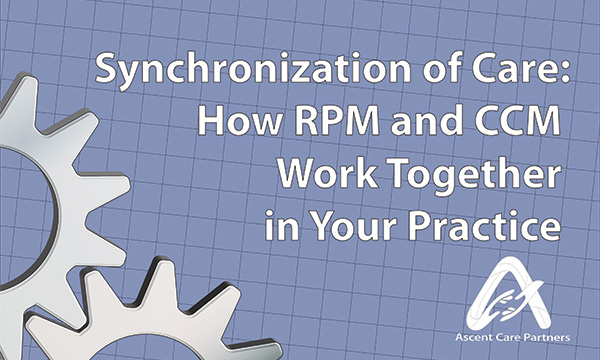The rapid adoption of telehealth services in recent years is an indication of the ever-evolving healthcare system. Virtual or remote care is now in demand and will continue to do so as more consumers see its value as an effective, cost-reducing, and convenient way of availing healthcare services.
Now, coming into prominence are the telehealth solutions like Remote Patient Monitoring (RPM) and Chronic Care Management (CCM). These solutions have revolutionized the delivery of care by widening access like never before and catering to the most high-risk, high-cost patient population or patients with chronic illnesses.
RPM and CCM also have been credited with improving patient engagement and delivering positive health outcomes. When utilized together, it substantially reduces cost and addresses head-on the many challenges of providing chronic care.
How do RPM and CCM work? Why is doing both a better strategy than just either one?
RPM and CCM: Knowing the Basics
RPM is the delivery of healthcare that uses telecommunications technologies to capture patient data and electronically transmit them to a clinician for review. To summarize some noteworthy points from a previous blog on Is RPM Important To Your Practice, it provides proactive preventive care by reducing hospitalizations and inpatient readmissions as clinicians leverage real-time data to ascertain patients’ health status. It is able, therefore, to optimize remote care while bringing in billable services and producing an additional revenue stream to a practice.
CCM, on the other hand, is a process of managing chronic care during the critical in-between office visits by ensuring compliance to care plans, adherence to medications, and keeping appointments with specialists. It ensures continuity of care, which is just one of many benefits discussed in What Is Chronic Care Management?. CCM enables chronic care patients to effectively manage their illnesses and allow them to lead a quality life. Like RPM, CCM also reduces costs and brings in revenues through reimbursements.
How these two solutions work well together is to simply imagine a physician treating chronic care patients wielding not just one potent weapon but two. These two complement each other perfectly so seeing them both in action makes tremendous sense.
How does RPM fit into CCM?
The Center for Medicare and Medicaid Services (CMS) first incentivized non-face-to-face CCM services in 2015 and RPM in 2018. Since then, the coverage and the rates have expanded to encourage providers and practices to embrace both telehealth technologies.
CMS fully supports both RPM and CCM. The combined revenues from Medicare claims are substantial because CMS acknowledged RPM as supplementary to CCM.
In the past, CCM has been hampered by the lack of coordination among clinicians who provide different aspects of care, especially to patients with more than one chronic condition, which is often the case. Patients find it difficult to work with several providers, even more so, sticking to any one of the programs prescribed for them. This type of fragmented care can impact negatively on a patient’s health outcomes, resulting in hospitalizations and unplanned ER visits.
RPM is able to bridge this fragmented care by capturing real-time data to monitor vital signs related to several chronic conditions. Take the case of managing patients with hypertension. A remote blood pressure monitor is able to monitor measurements constantly. Any abnormal changes are quickly detected so the condition will not escalate into an emergency one. Here, RPM supports CCM by providing critical insights to clinicians for proactive and preventative care.
Together, RPM and CCM consolidate care, bringing in these measurable outcomes:
- Optimized patient care including engagement and satisfaction
- Improved health outcomes through immediate detection and intervention
- Reduced costs with fewer hospitalizations and ER visits
- Better education and awareness among patients and caregivers
- Reduced burden on the healthcare system
- A new revenue stream from billable reimbursements
RPM and CCM Together: A Better Strategy
By having both RPM and CCM together, it becomes one adaptable solution that can be shaped to meet a clinician’s requirements. The eligible services of both RPM and CCM complement each other, and clinicians can easily strategize on which ones they wish to utilize to optimize their efforts during a month since both services can be billed concurrently in the same period. CMS allows the “stacking” of RPM and CCM in the same month as long as there is no double-counting of minutes.
To illustrate, a physician may opt to spend more time on patient education, so to bill for RPM, the CPT code 99457 is used. This particular code requires interactive and synchronous communication. As such, there is now more time to conduct a CCM service like coordinating care among providers, updating patients’ health records and care plans, as well as conducting monthly reviews of clinical charts.
Another example is that a physician may want to do more reviews of patients’ data, measurements and alerts so the CPT code 99454 is used. This will make room for CCM to be used on patient communication and education through audio or video calls, writing of patient letters, or exchanging messages.
RPM can be used to improve CCM, especially for patients with only one chronic condition who do not qualify for CCM. Moreover, both RPM and CCM offer patients, providers, and the entire healthcare system, an effective strategy to improve not only patient health but also financial outcomes.
Difference Between Remote Patient Monitoring and Chronic Care Management
Chronic care management (CCM), created in 2015, by the Centers for Medicare and Medicaid Services (CMS) to open possibilities in telehealth services is approaching the end of its third year. Yet, multiple providers have opted not to deliver CCM services – the reporting conditions and eligibility has been a considerable obstacle. Associated with the point that the median number of CCM patients per physician is 10, remote patient monitoring (RPM) is appearing as more appealing option for Providers due to the staff needs, reimbursement rate, patient eligibility and service flexibility. RPM has the possibility to earn rapid traction that CCM could not.
| RPM | CPM | |
| Patient Eligibility | 1+ chronic conditions | 2+ chronic conditions |
| Reimbursement | Approx $116/month | Approx $42/month |
| Staff Requirements | Physicians, QHP, Clinical Staff | Physicians and QHP |
| Monitoring | 20 minutes/month | 20-60 minutes/month |
| Availability | – | 24/7 Access must be provided |
| Billing | Calendar Month | Calendar Month |
The Program and The Tool That Works
Though RPM and CCM work well together, it should be mentioned that they have separate duties, which is why CMS emphasizes there cannot be any double-counting. A physician cannot spend CCM time on RPM patients or the other way around. RPM is specifically designed to improve clinical efficiency and chronic care. At present, physicians cannot just rely on telephone communication or even ignore the importance of taking daily measures of patients. This is why RPM is a natural and vital component for an effective CCM program. To put it simply, CCM is the program and RPM is the tool that makes it work better. Incidentally, RPM can also be used not only for chronic care but also in acute care in pre and post-surgery monitoring, and temporary rehabilitation care.
Because RPM and CCM are not the same, physicians must choose a vendor with indisputable solutions for each service that would pass a rigorous CMS audit. The same vendor should also have intricate regulatory knowledge and experience in supporting successful RPM and CCM programs within various physician practices. Ascent Care Partners or ACP can enhance your CCM with RPM with our turnkey RPM and CCM solutions. We leverage our years of experience helping primary care physicians optimize their patient care while maximizing their revenues with no upfront cost or risks on their part. Talk to us or schedule a meeting to learn more.



